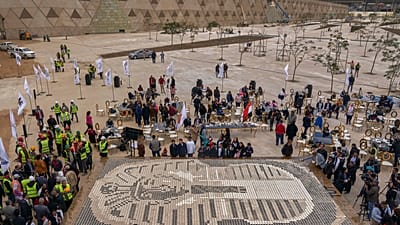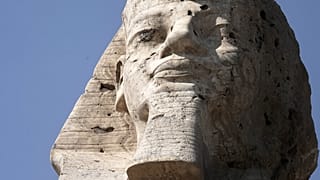Egypt
After two decades of anticipation, delays, and global curiosity, Egypt is finally ready to unveil the Grand Egyptian Museum (GEM) — the world’s largest museum dedicated to a single civilization. Located at the foot of the Giza Pyramids, the $1-billion landmark will officially open its doors on Saturday, marking a major milestone for Egypt’s cultural diplomacy and tourism ambitions.
Designed by Irish firm Heneghan Peng Architects, GEM features a monumental glass façade inspired by the geometry of the pyramids. Inside, visitors are greeted by a 36-foot-tall granite statue of Ramesses the Great before ascending a grand staircase lined with statues spanning thousands of years of history — all leading to a panoramic view of the pyramids.
But the museum’s most anticipated treasure is the full collection of King Tutankhamun.
“Why this museum is so important, and everyone is waiting for the opening? Because of Tutankhamun. And also, it is the largest museum in the world. This museum is really making all the objects to be alive,” says renowned Egyptologist and former Minister of Antiquities Zahi Hawass.
Tutankhamun’s Collection Displayed in Full for the First Time
For the first time since Howard Carter discovered the tomb in 1922, all 5,000 objects from Tutankhamun’s burial chamber will be displayed together across two dedicated halls. Many of the treasures have undergone meticulous restoration at GEM’s state-of-the-art conservation center.
“The lab here is honored to be responsible for the restoration of the masterpiece of King Tutankhamun — the three funerary beds and the six chariots… we secured them so that they arrive here in the museum without any losses. And in fact, they reached here with a safety level of 100%,” explains Jailan Mohamed, head of the wood restoration lab.
Among the highlights are the boy king’s golden throne, the gold-covered sarcophagus, the iconic funeral mask of gold and precious stones, and the pharaoh’s chariots — all showcased as they were found more than a century ago.
Another star exhibit is the 4,600-year-old solar boat of King Khufu, transferred intact on a custom vehicle from its original site beside the Great Pyramid.
A Tourism Game-Changer for Egypt
With 50,000 artifacts spanning prehistoric to Roman Egypt and 24,000 square meters of exhibition space — far surpassing the Louvre’s 35,000 displayed pieces — GEM is poised to transform Egypt’s tourism industry.
“A museum with this size is expected to increase the number of tourists to Egypt… we’re anticipating this will increase the numbers coming by at least 10% or 20%,” says Ahmed Ghoneim, CEO of the Grand Egyptian Museum.
The opening comes as Egypt targets 30 million tourists annually by 2032, after welcoming a record 15.7 million in 2024. Authorities have also overhauled the surrounding area with upgraded roads, a new metro station under construction, and the nearby Sphinx International Airport to ease visitor access.
A Cultural Mega-Project Years in the Making
Construction began in 2005 but was halted during the 2011 revolution. Political and regional instability forced several postponements, including this year’s delay due to Middle East conflicts. Now, with world leaders expected at Saturday’s ceremony, Egypt is ready for its most significant cultural opening of the century.
The museum sits at the crossroads of ancient history and a modern tourism revival — linking directly to the Giza plateau via pedestrian paths and eco-friendly transport. Daily visitor numbers are expected to reach 15,000 to 20,000, according to museum administrators.
The Grand Egyptian Museum is not only a home for ancient treasures — it is a bold statement of national pride, a long-awaited promise finally fulfilled, and a new gateway for the world to rediscover Egypt’s past.














00:59
Egypt opens bid to privatise Hurghada International Airport
11:17
Simandou iron ore: Guinea’s mega project set to transform global mining [Business Africa]
01:43
Egyptians vote in second phase of parliamentary elections
Go to video
Al Ahly and JS Kabylie to face off in CAF group-stage opener
01:07
Thieves steal ancient statues from Syria's National Museum of Damascus
01:13
Egypt's Foreign Minister engages with Sudan's military leader in Port Sudan